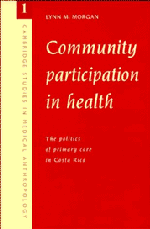Book contents
- Frontmatter
- Contents
- List of illustrations
- List of tables
- Acknowledgments
- List of abbreviations
- 1 The political symbolism of health
- 2 Banana medicine: the United Fruit Company in Costa Rica
- 3 The international imperative: foreign aid for health in Costa Rica
- 4 The primary health care movement and the political ideology of participation in health
- 5 Participation in Costa Rica: dissent within the state
- 6 La Chira: participation in a banana-growing community
- 7 The political economy of participation
- References
- Index
4 - The primary health care movement and the political ideology of participation in health
Published online by Cambridge University Press: 29 January 2010
- Frontmatter
- Contents
- List of illustrations
- List of tables
- Acknowledgments
- List of abbreviations
- 1 The political symbolism of health
- 2 Banana medicine: the United Fruit Company in Costa Rica
- 3 The international imperative: foreign aid for health in Costa Rica
- 4 The primary health care movement and the political ideology of participation in health
- 5 Participation in Costa Rica: dissent within the state
- 6 La Chira: participation in a banana-growing community
- 7 The political economy of participation
- References
- Index
Summary
Every so often an innovative new health strategy promises to revolutionize the world's health profile. So it was with the primary health care (PHC) movement of the 1970s. PHC became famous following the Alma Ata Conference sponsored by the World Health Organization and UNICEF in the Soviet Union in 1977, where conferees coined the nowfamous slogan, “Health for all by the year 2000.” The PHC strategy was based on the realization that health problems exacting the highest toll on Third World peoples could be alleviated with relatively simple health and sanitary measures, assuming that dispersed rural populations could be given access to such services. (The U.S. Agency for International Development estimated that less than 20 percent of people in developing countries had access to basic health services in 1980 [AID 1980: 10].) Two components of the PHC strategy were designed to meet these needs: (1) extending basic health services (such as immunization, sanitation, family planning, and nutritional surveillance) to underserved areas of less-developed countries; and (2) using community participation to improve health.
The primary health care strategy was indeed an improvement over medical models then prevailing in the developing world. Earlier initiatives emphasized costly, urban, hospital-based, curative services while PHC emphasized rural, community-based, low-cost, preventative services to be provided by village health workers, paraprofessional health assistants, or nursing auxiliaries. Primary health programs provided the impetus for many Third World governments to expand their health infrastructures, building rural health posts and secondary care clinics throughout the countryside.
- Type
- Chapter
- Information
- Community Participation in HealthThe Politics of Primary Care in Costa Rica, pp. 62 - 82Publisher: Cambridge University PressPrint publication year: 1993



